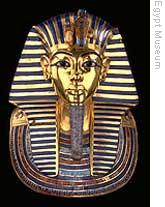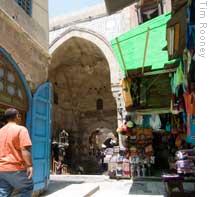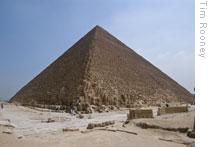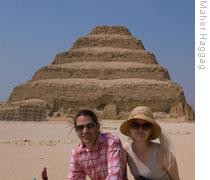VOA慢速英语-EXPLORATIONS - A Visit to the Cultural Treasures in
搜索关注在线英语听力室公众号:tingroom,领取免费英语资料大礼包。
(单词翻译)
For centuries, the buildings of ancient Egypt have captured the attention of historians1, artists, and travelers. Transcript2 of radio broadcast:
15 July 2008
VOICE ONE:
I'm Steve Ember.
VOICE TWO:
 |
| Cairo at sunset |
And I'm Faith Lapidus with EXPLORATIONS in VOA Special English. Today, we continue our travels through Egypt to explore one of the greatest civilizations in human history. Last week, we visited the Nile River valley to see the art and architecture of ancient Egypt.
Today, we explore the buildings of ancient Egyptians in and around Cairo. And, we visit other more modern cultural treasures in the capital city.
(MUSIC)
VOICE ONE:
Welcome to Cairo, the largest city in Africa and the Middle East. This huge city is home to about seven million people. Cairo is equally great for its many traditions, cultures, and monuments. We begin our visit in the center of the city on the banks of the Nile river.
(SOUND: Traffic)
Looking at the countless3 buildings, cars, people, and boats it is hard to imagine the historical roots of this modern place. The beginning of Cairo as a city dates to the year nine sixty-nine when Muslim invaders4 from Tunisia took control of the area. The word Cairo comes from the Arabic word "al-Qahira" meaning "the victorious5."
VOICE TWO:
Many rulers, such as the Fatimids, the Ayyubids, the Mamelukes and the Ottomans, controlled Egypt over the centuries. Starting in the late nineteenth century, Britain controlled the country for about seventy years. Each of these cultures left its mark on the culture and building design of Cairo.
In the late eighteenth century, the French general Napoleon Bonaparte briefly6 took control of Egypt. He brought with him over one hundred and fifty experts and scientists to document the monuments, arts, plants and animals of Egypt. Over several years, thousands of artists worked to put together the collection of books called the "Description de l'Egypte."
VOICE ONE:
For many Europeans, these detailed7 descriptions brought to life a culture that was unknown to them and very exciting. By the middle of the nineteenth century, Egypt became a popular destination for European travelers, writers, and artists. Ancient Egypt influenced European architecture, art and opera. This interest also had some unfortunate effects. European travelers in Egypt often took ancient treasures illegally. Many important objects ended up in the national museums of Britain, France and Germany.
VOICE TWO:
In eighteen thirty-five, the Egyptian government started the Egyptian Antiques8 Service. Its aim was to stop the stealing of ancient objects and gather a national collection for a museum. Today, visitors can spend many hours enjoying the Egyptian Museum in Cairo. It houses an estimated one hundred twenty thousand objects from all periods of ancient Egyptian history.
VOICE ONE:
 |
| Tutankhamun's gold mask |
One of the most popular rooms in the museum contains the funeral objects of the Egyptian pharaoh Tutankhamun. Last week we visited his burial site. But in the museum, visitors can see the strikingly9 beautiful objects with which he was buried three thousand three hundred years ago. The skill and imagination of the artisans that made Tutankhamun's treasures are extraordinary.
For example, his detailed death mask weighs eleven kilograms and is made from jewels and solid gold. It gives a stylized image of the young ruler's face.
(MUSIC)
VOICE TWO:
Visiting the area of the city called Old Cairo provides an interesting lesson in religious history. Before Islam came to Egypt, the main religion of the area was Christianity. Egyptian Christians10 are known as Copts. You can visit the Coptic religious center known as the Hanging Church. This ninth century structure was built on top of an ancient Roman gate.
Or you can visit the third century Church of Saint11 Sergius. Many people believe the church is built over a cave where Mary, Joseph and the baby Jesus hid while fleeing from Judea. Nearby is the oldest Jewish religious center in Egypt. The Ben Ezra Synagogue dates back to the ninth century.
VOICE ONE:
In another area known as Islamic Cairo, there are many historically important mosques13.
(SOUND: Call to Prayer)
For example, the Al-Azhar Mosque12 has been a religious center and university for over a thousand years. The Mosque of Sayyidna al-Hussein is one of the most holy Islamic buildings in Egypt. It is believed to be the burial place of the head of Hussein, the grandson of the Prophet14 Muhammed.
VOICE TWO:
 |
| Entering the Khan al-Khalili |
For an unforgettable shopping experience, you can visit the Khan al-Khalili. Since the fourteenth century, the traders of Cairo have been selling their goods there. Today, you can buy anything from jewelry15 and belly-dancing costumes to spices and floor coverings.
Inside the market area, visitors can stop at the Mahfouz Café to enjoy some mint16 tea or smoke a sheesha pipe. The café was named after the Nobel Prize winning Egyptian writer Naguib Mahfouz who grew up in this part of the city. His stories capture the sights and sounds of Cairo and its people.
(MUSIC)
VOICE ONE:
No visit to Cairo could be complete without a trip to see some of the most famous buildings in the world. In the area of the city called Giza, three huge stone pyramids rise out of the desert sands. For thousands of years, these extraordinary buildings have served as funeral monuments honoring three ancient Egyptian kings.
The nineteenth century French writer Gustave Flaubert wrote this about the pyramids after visiting them: "Khafre's pyramid seems to me inordinately17 huge and completely sheer18; It's like a cliff, like a thing of nature, a mountain …"
His words help express the unbelievable size and power of these limestone19 buildings.
VOICE TWO:
 |
| The Great Pyramid of Khufu |
The oldest and largest is called the Great Pyramid of Khufu, built as the burial place for this ancient king. This tomb is the last survivor20 of the Seven Wonders of the World. When it was built four thousand five hundred years ago, it stood one hundred forty-six meters tall. Experts estimate that about two million three hundred thousand limestone blocks were used to build this remarkable21 tomb. And, each limestone block weighs two and one-half tons.
The famous statue of the Sphinx sits nearby. Experts still debate the age and meaning of this ancient statue, which has the head of a man and the body of a lion.
VOICE ONE:
 |
| The writer and her husband, Tim Rooney, at the Step Pyramid |
Experts still do not know exactly how the ancient Egyptians were able to build such technically22 perfect buildings. How were the ancient builders able to move the huge stone blocks from the quarries23 where they were cut to the building area? How were they able to raise them to the higher levels of the monuments? And what kind of tools did these ancient builders use to cut stone as hard as granite24?
VOICE TWO:
Over the centuries pyramidologists have developed many interesting theories about how the structures were built. Some believe they were built with help from alien creatures from space. Others believe slaves of the pharaoh were forced to build these structures. Our tour guide Maher Haggag has a different theory about why workers built these structures.
MAHER HAGGAG: "Slaves could have never ever created perfection25 like this. It wasn't slavery, it was a privilege for them. People had a passion to build something like this. Just by their own bare hands. No technology had been involved, just faith and they loved what they'd been doing."
VOICE ONE:
Outside of Cairo, the ancient burial area of Saqqara helps explain the development of the pyramid structure. The architect Imhotep designed the Step Pyramid over four thousand six hundred years ago for the pharaoh Zoser. It is the first known stone monument ever built. Imhotep designed it so that Zoser's burial monument would last forever. Before, royal tombs were built with mud brick materials that were easily damaged over time.
VOICE TWO:
Imhotep's idea of stacking layers of stone led to the development of the pyramid tomb. From Saqqara you can look far off in the distance to see pyramids built for a later ruler of Egypt, Sneferu. The Bent26 Pyramid starts at a sharp angle, then becomes more flat towards its top. Architects did not yet know the correct angle with which to build a stable pyramid. They tried again with the nearby Red Pyramid. This structure is considered the oldest true pyramid in the world.
VOICE ONE:
 |
| A felucca owner sailing on the Nile in Cairo |
After a day exploring Cairo, there is nothing more relaxing than hiring a felucca boat to sail you up and down the Nile. As you watch the sun set on this magical city, you can think about its many cultural treasures, old and new.
(MUSIC)
VOICE TWO:
This program was written and produced by Dana Demange. I'm Faith Lapidus.
VOICE ONE:
And I'm Steve Ember. To see pictures of Egypt, visit our Web site, voaspecialenglish.com. Join us again next week for EXPLORATIONS in VOA Special English.
 收听单词发音
收听单词发音 




